Synthesis of Cu-Doped TiO2 on Wood Substrate with Highly Efficient Photocatalytic Performance and Outstanding Recyclability for Formaldehyde Degradation
Abstract
:1. Introduction
2. Results and Discussion
2.1. Structural and Morphological Characterization
2.2. Optical Properties
2.3. Photocatalytic Activity
2.4. Recyclability of Cu-TiO2/Wood Composites
2.5. Summary of Photocatalytic Mechanism
3. Materials and Methods
3.1. Materials and Chemicals
3.2. Preparation of Cu-TiO2/Wood Composites
3.3. Characterization
3.4. Photocatalytic Activity
3.5. Recyclability of Cu-TiO2/Wood Composites
4. Conclusions
Supplementary Materials
Author Contributions
Funding
Institutional Review Board Statement
Informed Consent Statement
Data Availability Statement
Acknowledgments
Conflicts of Interest
References
- Chen, P.W.; Kuo, T.C.; Liu, Z.S.; Lu, H.F. Assessment of the mutagenicity of two common indoor air pollutants, formaldehyde and toluene. Indoor Air. 2021, 31, 1353–1363. [Google Scholar] [CrossRef] [PubMed]
- Fu, Y.; Xin, M.; Chong, J.; Li, R.; Huang, M. Plasmonic gold nanostars@ ZIF-8 nanocomposite for the ultrasensitive detection of gaseous formaldehyde. J. Mater. Sci. 2021, 56, 4151–4160. [Google Scholar] [CrossRef]
- Jin, W.; Chen, G.; Duan, X.; Yin, Y.; Ye, H.; Wang, D.; Yu, J.; Mei, X.; Wu, Y. Adsorption behavior of formaldehyde on ZnO (101¯ 0) surface: A first principles study. Appl. Surf. Sci. 2017, 423, 451–456. [Google Scholar] [CrossRef]
- He, C.; Cheng, J.; Zhang, X.; Douthwaite, M.; Pattisson, S.; Hao, Z. Recent advances in the catalytic oxidation of volatile organic compounds: A review based on pollutant sorts and sources. Chem. Rev. 2019, 119, 4471–4568. [Google Scholar] [CrossRef]
- Chang, Z.; Wang, C.; Zhang, G. Progress in degradation of volatile organic compounds based on low-temperature plasma technology. Plasma Processe. Polym. 2020, 17, 1900131. [Google Scholar] [CrossRef]
- Liu, Y.; Ye, Z.; Li, D.; Wang, M.; Zhang, Y.; Huang, W. Tuning CuOx-TiO2 interaction and photocatalytic hydrogen production of CuOx/TiO2 photocatalysts via TiO2 morphology engineering. Appl. Surf. Sci. 2019, 473, 500–510. [Google Scholar] [CrossRef]
- Nosaka, Y.; Nosaka, A.Y. Generation and detection of reactive oxygen species in photocatalysis. Chem. Rev. 2017, 117, 11302–11336. [Google Scholar] [CrossRef] [PubMed]
- Li, A.; Zhu, W.; Li, C.; Wang, T.; Gong, J. Rational design of yolk–shell nanostructures for photocatalysis. Chem. Soc. Rev. 2019, 48, 1874–1907. [Google Scholar] [CrossRef]
- Mamaghani, A.H.; Haghighat, F.; Lee, C.-S. Photocatalytic oxidation technology for indoor environment air purification: The state-of-the-art. Appl. Catal. B Environ. 2017, 203, 247–269. [Google Scholar] [CrossRef]
- Kanan, S.; Moyet, M.A.; Arthur, R.B.; Patterson, H.H. Recent advances on TiO2-based photocatalysts toward the degradation of pesticides and major organic pollutants from water bodies. Catal. Rev. 2020, 62, 1–65. [Google Scholar] [CrossRef]
- Zhang, Q.; Du, R.; Tan, C.; Chen, P.; Yu, G.; Deng, S. Efficient degradation of typical pharmaceuticals in water using a novel TiO2/ONLH nano-photocatalyst under natural sunlight. J. Hazard. Mater. 2021, 403, 123582. [Google Scholar] [CrossRef] [PubMed]
- Portela, R.; Jansson, I.; Suárez, S.; Villarroel, M.; Sánchez, B.; Avila, P. Natural silicate-TiO2 hybrids for photocatalytic oxidation of formaldehyde in gas phase. Chem. Eng. J. 2017, 310, 560–570. [Google Scholar] [CrossRef]
- Li, C.; Sun, Z.; Song, A.; Dong, X.; Zheng, S.; Dionysiou, D.D. Flowing nitrogen atmosphere induced rich oxygen vacancies overspread the surface of TiO2/kaolinite composite for enhanced photocatalytic activity within broad radiation spectrum. Appl. Catal. B Environ. 2018, 236, 76–87. [Google Scholar] [CrossRef]
- Tian, L.; Xing, L.; Shen, X.; Li, Q.; Ge, S.; Liu, B.; Jie, L. Visible light enhanced Fe–I–TiO2 photocatalysts for the degradation of gaseous benzene. Atmos. Pollut. Res. 2020, 11, 179–185. [Google Scholar] [CrossRef]
- Devi, L.G.; Kavitha, R. A review on non metal ion doped titania for the photocatalytic degradation of organic pollutants under UV/solar light: Role of photogenerated charge carrier dynamics in enhancing the activity. Appl. Catal. B Environ. 2013, 140, 559–587. [Google Scholar] [CrossRef]
- Wang, W.; Zhang, J.; Liang, D.; Li, Y.; Xie, Y.; Wang, Y.; Li, J. Anodic oxidation growth of lanthanum/manganese-doped TiO2 nanotube arrays for photocatalytic degradation of various organic dyes. J. Mater. Sci. Mater. Electron. 2020, 31, 8844–8851. [Google Scholar] [CrossRef]
- Huang, Q.; Hu, Y.; Pei, Y.; Zhang, J.; Fu, M. In situ synthesis of TiO2@ NH2-MIL-125 composites for use in combined adsorption and photocatalytic degradation of formaldehyde. Appl. Catal. B Environ. 2019, 259, 118106. [Google Scholar] [CrossRef]
- Tang, W.; Qiu, K.; Zhang, P.; Yuan, X. Synthesis and photocatalytic activity of ytterbium-doped titania/diatomite composite photocatalysts. App. Surf. Sci. 2016, 362, 545–550. [Google Scholar] [CrossRef]
- Wang, B.; de Godoi, F.C.; Sun, Z.; Zeng, Q.; Zheng, S.; Frost, R.L. Synthesis, characterization and activity of an immobilized photocatalyst: Natural porous diatomite supported titania nanoparticles. J. Colloid. Interf. Sci. 2015, 438, 204–211. [Google Scholar] [CrossRef] [Green Version]
- Hu, X.; Li, C.; Sun, Z.; Song, J.; Zheng, S. Enhanced photocatalytic removal of indoor formaldehyde by ternary heterogeneous BiOCl/TiO2/sepiolite composite under solar and visible light. Build. Environ. 2020, 168, 106481. [Google Scholar] [CrossRef]
- Chen, F.; Liu, S.; Yu, J. Efficient removal of gaseous formaldehyde in air using hierarchical titanate nanospheres with in situ amine functionalization. Phys. Chem. Chem. Phys. 2016, 18, 18161–18168. [Google Scholar] [CrossRef] [PubMed]
- Che, W.; Xiao, Z.; Wang, Z.; Li, J.; Wang, H.; Wang, Y.; Xie, Y. Wood-based mesoporous filter decorated with silver nanoparticles for water purification. ACS Sustain. Chem. Eng. 2019, 7, 5134–5141. [Google Scholar] [CrossRef]
- Chen, C.; Kuang, Y.; Kuang, S.; Burgert, I.; Keplinger, T.; Gong, A.; Li, T.; Berglund, L.; Eichhorn, S.J.; Hu, L. Structure–property–function relationships of natural and engineered wood. Nat. Rev. Mater. 2020, 5, 642–666. [Google Scholar] [CrossRef]
- Yang, H.; Liu, Y.; Li, J.; Wang, C.; Li, Y. Full-wood photoluminescent and photothermic materials for thermal energy storage. Chem. Eng. J. 2021, 403, 126406. [Google Scholar] [CrossRef]
- Xiu, L.; Wang, Z.; Yu, M.; Wu, X.; Qiu, J. Aggregation-resistant 3D MXene-based architecture as efficient bifunctional electrocatalyst for overall water splitting. ACS Nano 2018, 12, 8017–8028. [Google Scholar] [CrossRef] [PubMed]
- Guan, H.; Cheng, Z.; Wang, X. Highly compressible wood sponges with a spring-like lamellar structure as effective and reusable oil absorbents. ACS Nano 2018, 12, 10365–10373. [Google Scholar] [CrossRef] [PubMed]
- Gao, L.; Gan, W.; Xiao, S.; Zhan, X.; Li, J. Enhancement of photo-catalytic degradation of formaldehyde through loading anatase TiO2 and silver nanoparticle films on wood substrates. RSC Adv. 2015, 5, 52985–52992. [Google Scholar] [CrossRef]
- Cai, T.; Kuang, L.; Wang, C.; Jin, C.; Wang, Z.; Sun, Q. Cellulose as an adhesive for the synthesis of carbon aerogel with a 3D hierarchical network structure for capacitive energy storage. ChemElectroChem 2019, 6, 2586–2594. [Google Scholar] [CrossRef]
- Wu, Y.; Jia, S.; Qing, Y.; Luo, S.; Liu, M. A versatile and efficient method to fabricate durable superhydrophobic surfaces on wood, lignocellulosic fiber, glass, and metal substrates. J. Mater. Chem. A. 2016, 4, 14111–14121. [Google Scholar] [CrossRef]
- Shi, L.; Benetti, D.; Li, F.; Wei, Q.; Rosei, F. Phase-junction design of MOF-derived TiO2 photoanodes sensitized with quantum dots for efficient hydrogen generation. Appl. Catal. B Environ. 2020, 263, 118317. [Google Scholar] [CrossRef]
- He, J.; Du, Y.E.; Bai, Y.; An, J.; Cai, X.M.; Chen, Y.Q.; Wang, P.F.; Yang, X.J.; Feng, Q. Facile Formation of Anatase/Rutile TiO2 Nanocomposites with Enhanced Photocatalytic Activity. Molecules 2019, 24, 2996. [Google Scholar] [CrossRef] [PubMed] [Green Version]
- Sheng, C.; Wang, C.; Wang, H.; Jin, C.; Sun, Q.; Li, S. Self-photodegradation of formaldehyde under visible-light by solid wood modified via nanostructured Fe-doped WO3 accompanied with superior dimensional stability. J. Hazard. Mater. 2017, 328, 127–139. [Google Scholar] [CrossRef]
- Sun, Q.; Lu, Y.; Liu, Y. Growth of hydrophobic TiO2 on wood surface using a hydrothermal method. J. Mater. Sci. 2011, 46, 7706–7712. [Google Scholar] [CrossRef]
- Li, J.; Chen, Y.; Wu, Z.; Bao, Y.; He, S.; Li, N.; Huang, C.; Chen, Z.; Lu, Y. A simple solution-phase route for room-temperature synthesis of mesoporous and nanocrystalline anatase TiO2. Inorg. Nano-Met. Chem. 2017, 47, 158–161. [Google Scholar] [CrossRef]
- Dong, F.; Wang, H.; Wu, Z.; Qiu, J. Marked enhancement of photocatalytic activity and photochemical stability of N–doped TiO2 nanocrystals by Fe3+/Fe2+ surface modification. J. Colloid. Interf. Sci. 2010, 343, 200–208. [Google Scholar] [CrossRef] [PubMed]
- Biesinger, M.C.; Lau, L.W.; Gerson, A.R.; Smart, R.S.C. Resolving surface chemical states in XPS analysis of first row transition metals, oxides and hydroxides: Sc, Ti, V., Cu and Zn. Appl. Surf. Sci. 2010, 257, 887–898. [Google Scholar] [CrossRef]
- Liu, S.; Wang, W.; Chen, J.; Li, J.-G.; Li, X.; Sun, X.; Dong, Y. Foamed single-crystalline anatase nanocrystals exhibiting enhanced photocatalytic activity. J. Mater. Chem. A 2015, 3, 17837–17848. [Google Scholar] [CrossRef]
- Zhang, L.; Chen, L.; Chen, L.; Zhu, G. A facile synthesis of flower-shaped TiO2/Ag microspheres and their application in photocatalysts. RSC Adv. 2014, 4, 54463–54468. [Google Scholar] [CrossRef]
- Zhao, B.; Wang, X.; Zhang, Y.; Gao, J.; Chen, Z.; Lu, Z. Synergism of oxygen vacancies, Ti3+ and N dopants on the visible-light photocatalytic activity of N-doped TiO2. J. Photochem. Photobio. A 2019, 382, 111928. [Google Scholar] [CrossRef]
- Yan, J.; Wang, M.-Q.; Du, S.-G.; Wang, B.; Zhang, X.-S. Preparation and characterization of micro-copper flakes/nano-TiO2 composite particles. Ceram. Int. 2015, 41, 3365–3370. [Google Scholar] [CrossRef]
- Chen, M.; Wang, H.; Wang, X.; Wang, F.; Qin, X.; Zhang, C.; He, H. High-performance of Cu-TiO2 for photocatalytic oxidation of formaldehyde under visible light and the mechanism study. Chem. Eng. J. 2020, 390, 124481. [Google Scholar] [CrossRef]
- Khan, M.R.; Chuan, T.W.; Yousuf, A.; Chowdhury, M.; Chowdhury, C.K. Schottky barrier and surface plasmonic resonance phenomena towards the photocatalytic reaction: Study of their mechanisms to enhance photocatalytic activity. Catal. Sci. Technol. 2015, 5, 2522–2531. [Google Scholar] [CrossRef]
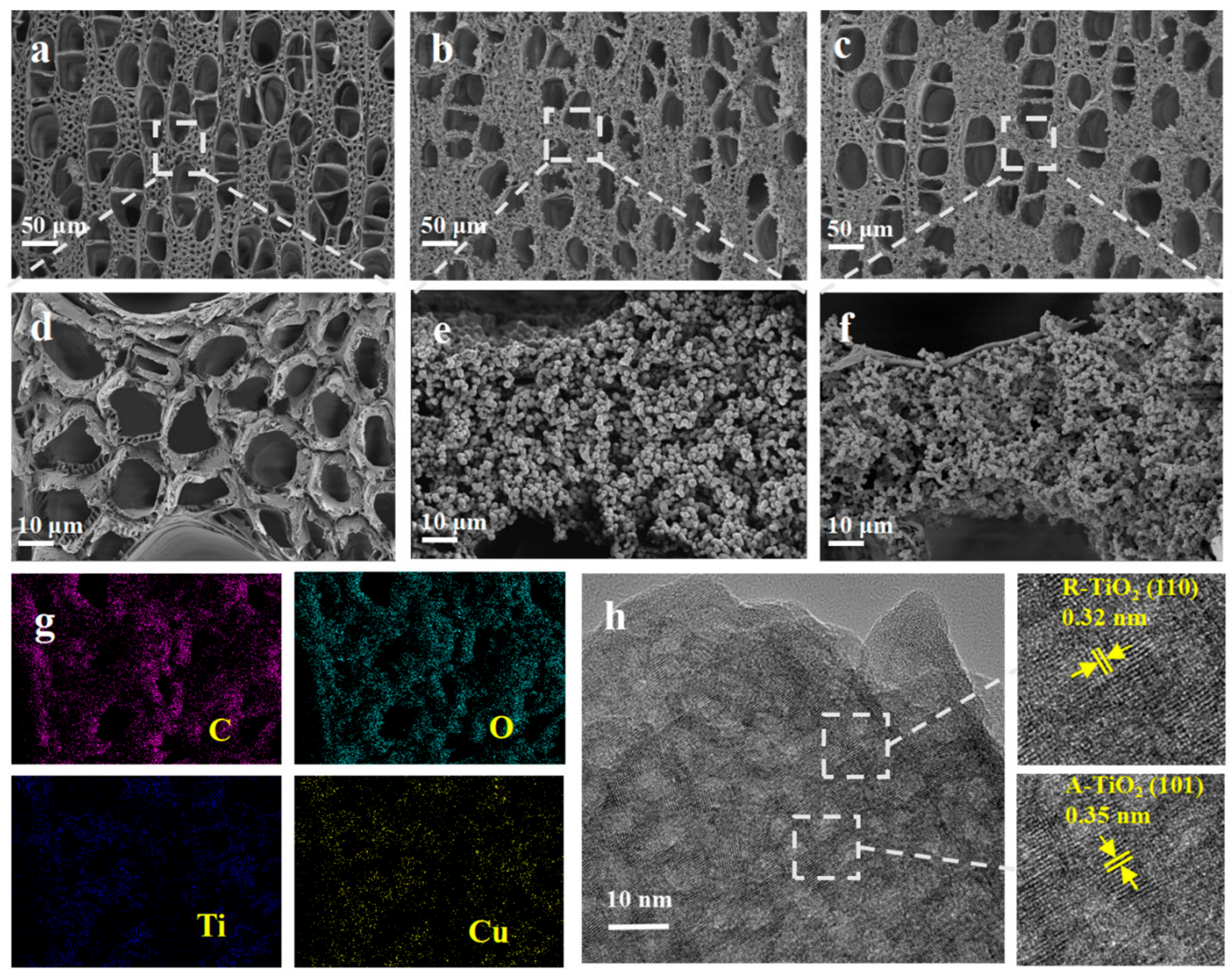
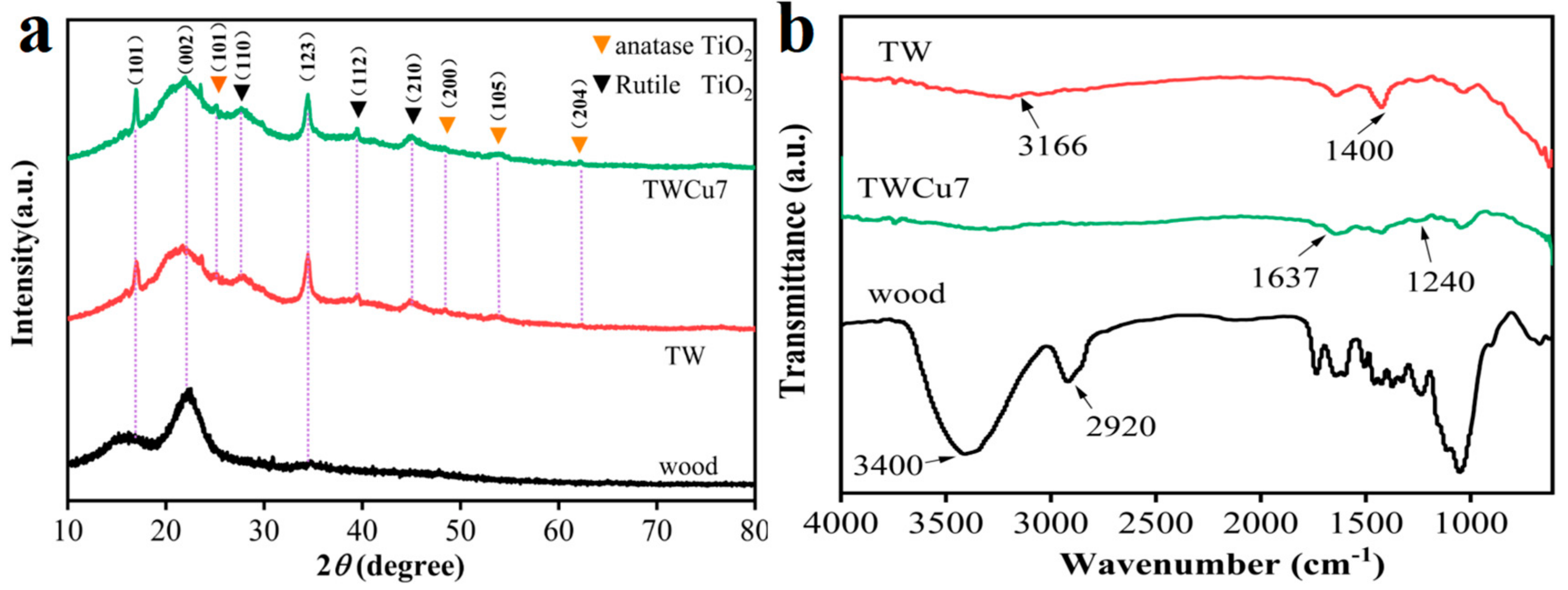

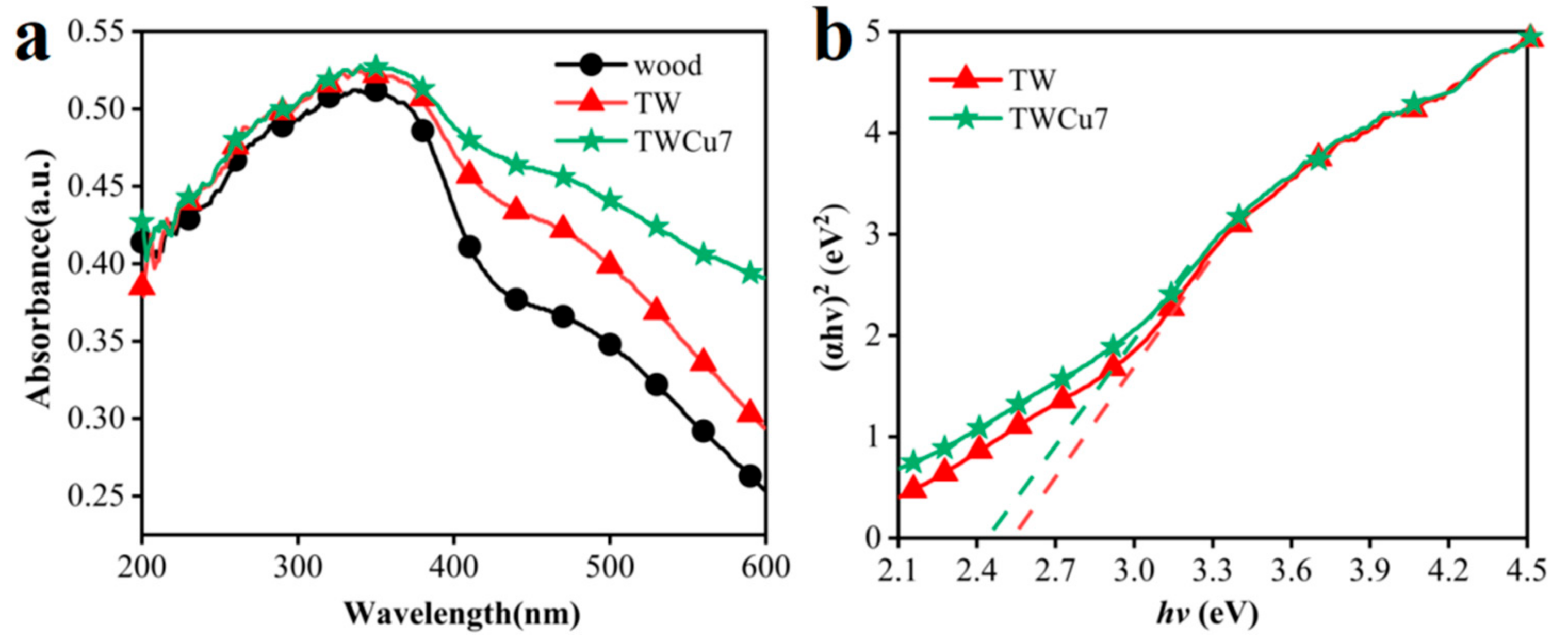

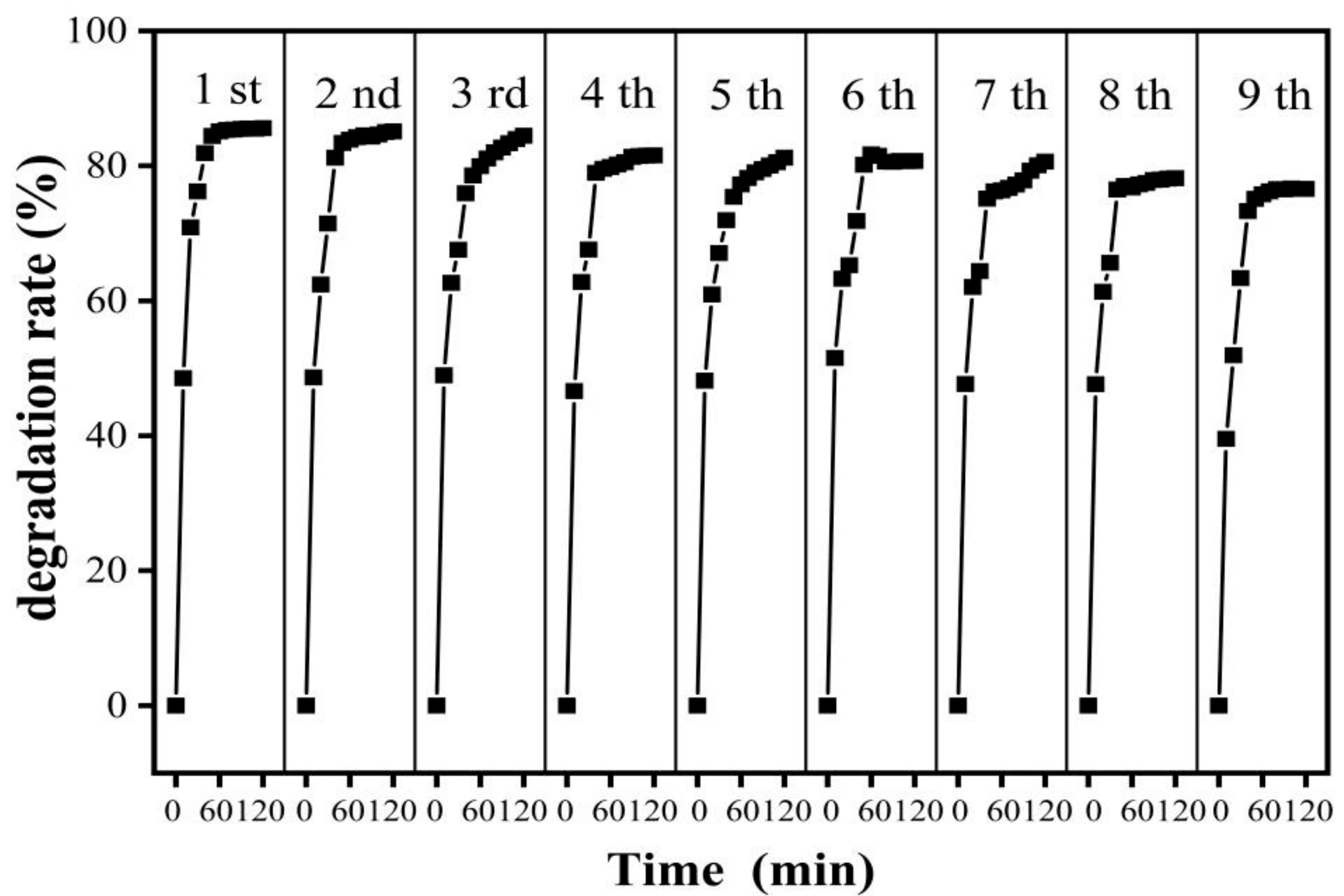
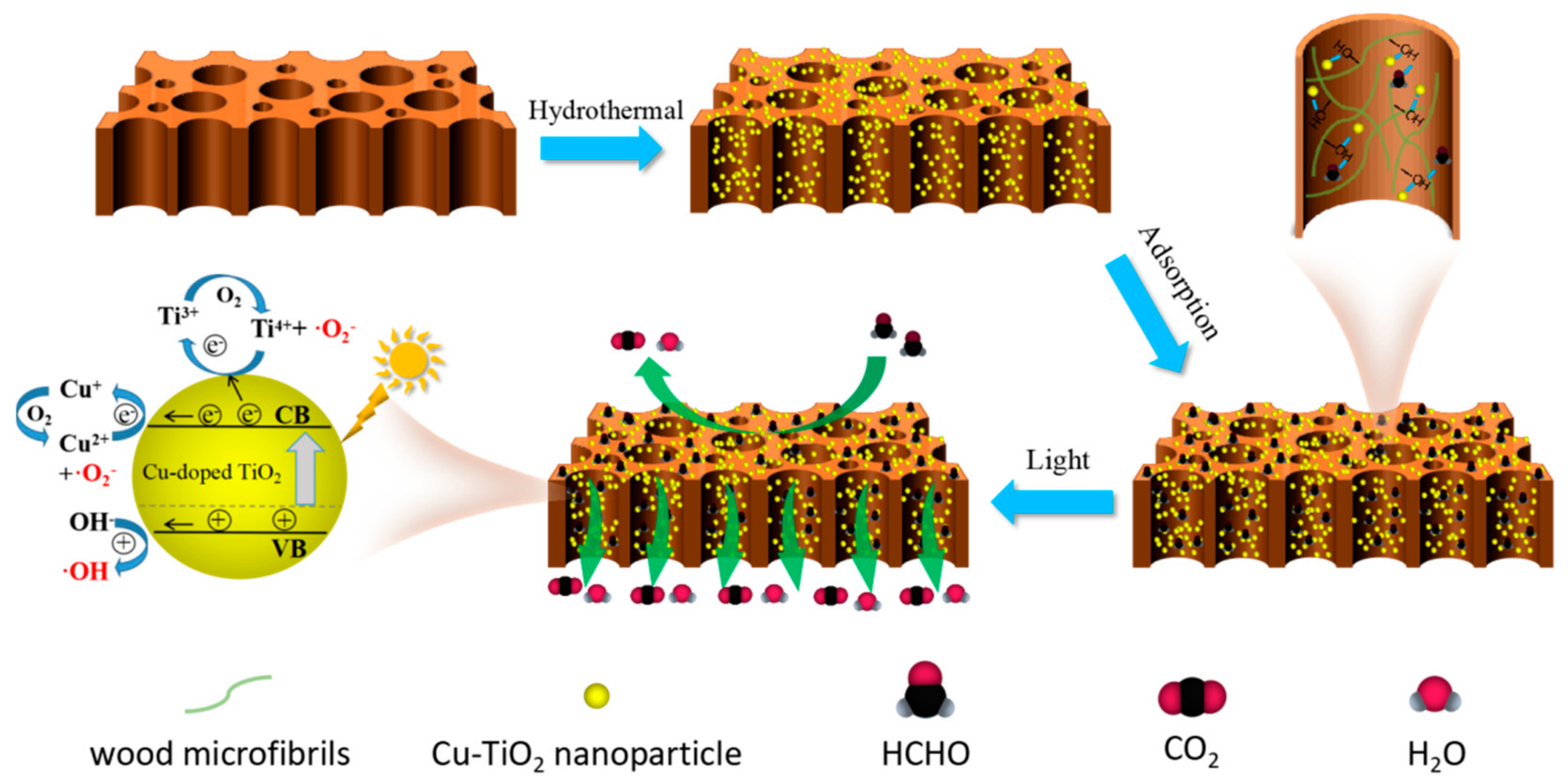
Disclaimer/Publisher’s Note: The statements, opinions and data contained in all publications are solely those of the individual author(s) and contributor(s) and not of MDPI and/or the editor(s). MDPI and/or the editor(s) disclaim responsibility for any injury to people or property resulting from any ideas, methods, instructions or products referred to in the content. |
© 2023 by the authors. Licensee MDPI, Basel, Switzerland. This article is an open access article distributed under the terms and conditions of the Creative Commons Attribution (CC BY) license (https://creativecommons.org/licenses/by/4.0/).
Share and Cite
Lv, Z.; Ma, Y.; Jia, S.; Qing, Y.; Li, L.; Chen, Y.; Wu, Y. Synthesis of Cu-Doped TiO2 on Wood Substrate with Highly Efficient Photocatalytic Performance and Outstanding Recyclability for Formaldehyde Degradation. Molecules 2023, 28, 972. https://doi.org/10.3390/molecules28030972
Lv Z, Ma Y, Jia S, Qing Y, Li L, Chen Y, Wu Y. Synthesis of Cu-Doped TiO2 on Wood Substrate with Highly Efficient Photocatalytic Performance and Outstanding Recyclability for Formaldehyde Degradation. Molecules. 2023; 28(3):972. https://doi.org/10.3390/molecules28030972
Chicago/Turabian StyleLv, Zhiqiang, Yi Ma, Shanshan Jia, Yan Qing, Lei Li, Yangyang Chen, and Yiqiang Wu. 2023. "Synthesis of Cu-Doped TiO2 on Wood Substrate with Highly Efficient Photocatalytic Performance and Outstanding Recyclability for Formaldehyde Degradation" Molecules 28, no. 3: 972. https://doi.org/10.3390/molecules28030972




